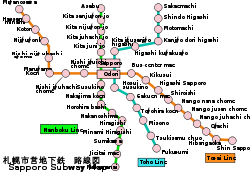Sapporo Municipal Subway: Difference between revisions
→Rolling stock: add 9000 series |
Roberto Dahigo Zahito Nagano (talk | contribs) mNo edit summary |
||
| Line 91: | Line 91: | ||
<gallery> |
<gallery> |
||
File:Sapporo subway type1000.JPG|1000 series (preserved) |
File:Sapporo subway type1000.JPG|1000 series (preserved) |
||
File: |
File:Sapporo Municipal Subway 3000 series.JPG|3000 series |
||
File:ST SN5000 20061102 001.jpg|5000 series |
File:ST SN5000 20061102 001.jpg|5000 series |
||
File:Sapporo Subway 6102 20050717 t01.jpg|6000 series |
File:Sapporo Subway 6102 20050717 t01.jpg|6000 series |
||
Revision as of 12:25, 19 July 2015
| Sapporo Municipal Subway | |||
|---|---|---|---|
 | |||
| Overview | |||
| Native name | 札幌市営地下鉄 Sapporo-shiei-chikatetsu | ||
| Locale | Sapporo, Hokkaido, Japan | ||
| Transit type | Rubber-tyred metro | ||
| Number of lines | 3 | ||
| Number of stations | 49 | ||
| Operation | |||
| Began operation | December 16, 1971 | ||
| Operator(s) | Sapporo City Transportation Bureau | ||
| Technical | |||
| System length | 48.0 km (29.8 mi) | ||
| Track gauge | None (there are no rails) | ||
| Electrification | 750 V DC third rail (Namboku LIne) 1,500 V DC overhead catenary (Tozai and Toho lines) | ||
| |||
The Sapporo Municipal Subway (札幌市営地下鉄, Sapporo-shiei-chikatetsu) is an underground rubber-tyred metro system in Sapporo, Hokkaido, Japan, operated by the Sapporo City Transportation Bureau.
Lines
The system consists of three lines: the green Namboku Line (North-South line), orange Tozai Line (East-West line), and blue Tōhō Line. The first, the Namboku Line, was opened in 1971 prior to the 1972 Winter Olympics. The Sapporo City Subway system operates out of two main hubs: Sapporo Station and Odori Station. Most areas of the city are within a reasonable walking distance or short bus ride from one of the subway stations.
The three lines all connect at Sapporo Station with the JR Hokkaido main lines. At Odori and Susukino stations, it connects to the streetcar (tram) above. The system has a total length of 48 km with 46 stations.
| Color & icon | Mark | Name | First section opened |
Last ex- tension |
Length | Stations | |
|---|---|---|---|---|---|---|---|
| green | N | Namboku Line | 1971 | 1978 | 14.3 km (8.9 mi) | 16 | |
| orange | T | Tōzai Line | 1976 | 1999 | 20.1 km (12.5 mi) | 19 | |
| sky blue | H | Tōhō Line | 1988 | 1994 | 13.6 km (8.5 mi) | 14 | |
| Total: | 48.0 km (29.8 mi) | 49 | |||||
Technology
The Sapporo Municipal Subway trains are guided by a central rail and move with rubber tires on two flat steel roll ways. This system is unique among subways in Japan. There are no guide bars because the central rail makes them superfluous.
- Sapporo Subway guide rail and flat steel roll ways
Rolling stock
Namboku Line
- 1000/2000 series (2/4/6/8-car formation with 2 doors per side, from 1971 until 1999)
- 3000 series (8-car formation with 2 doors per side, from 1978 until 2012)
- 5000 series (6-car formation with 4 doors per side, since 1997)
Tōzai Line
- 6000 series (7-car formation with 3 doors per side, from 1976 until 2008)
- 8000/8300 series (7-car formation with 3 doors per side, since 1998)
Tōhō Line
- 7000 series (4-car formation with 3 doors per side, since 1988)
- 9000 series (4-car formation with 3 doors per side, since May 2015)[1]
- 1000 series (preserved)
- 3000 series
- 5000 series
- 6000 series
- 7000 series
- 8000 series
Fares
Ticket prices range from 200 yen to 360 yen, depending on the distance to travel. Day passes and discount passes can be purchased at the vending machines. Prepaid "With You" cards can be used for the subway, streetcar and regular city routes offered by JR Hokkaido Bus, Chuo Bus and Jotetsu Bus.
One-day Cards offer unlimited rides on the subway, streetcar, and regular city routes offered by the Chuo, Jotetsu, and JR Hokkaido Buses (excluding some suburban areas) on the day of purchase. A subway one-day card, for use only on the subway, is also available. Donichika-Tickets allow for unlimited one-day ride pass for the subway to be used only on Saturdays, Sundays and national holidays.
Commuter passes offer unlimited rides between specific stations during their period of validity. There are two types of commuter pass: one for those commuting to their workplace and one for students; both are available for one- or three-month periods, and can be purchased from commuter pass sales offices located at major stations. All stations accept the SAPICA rechargeable IC cards which can be used as a fare card for the subway.
Shopping areas
There are two main shopping areas located underground, connected to the exits of three central stations on the Namboku line: Sapporo Station, Susukino Station, and Odori Station. Pole Town is an extensive shopping area that lies between Susukino and Odori stations. Aurora Town is a shopping arcade that is connected to Sapporo station. It links some of the main shopping malls in Sapporo, such as Daimaru, JR Tower, Esta, and Stellar Palace.[2]
References
- ^ 札幌市営地下鉄東豊線で9000形が営業運転を開始. Japan Railfan Magazine Online (in Japanese). Japan: Koyusha Co., Ltd. 9 May 2015. Retrieved 9 May 2015.
{{cite web}}: Unknown parameter|trans_title=ignored (|trans-title=suggested) (help) - ^ "Pole Town and Aurora Town - Go! Sapporo". gosapporo.com. Retrieved 30 January 2015.








